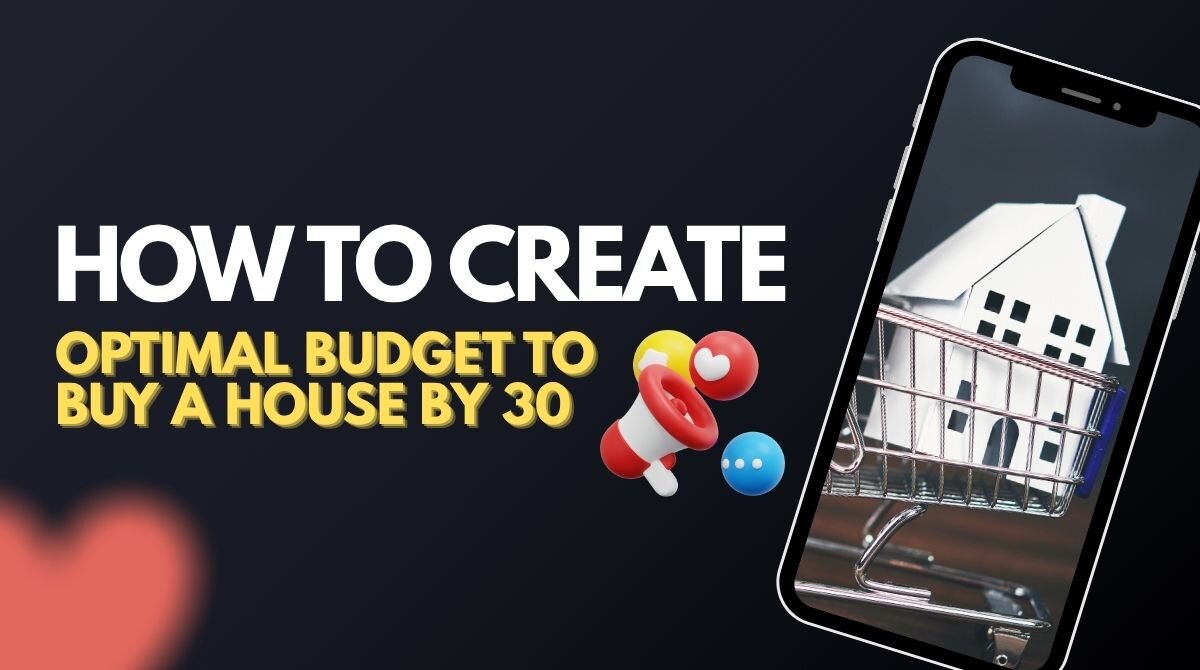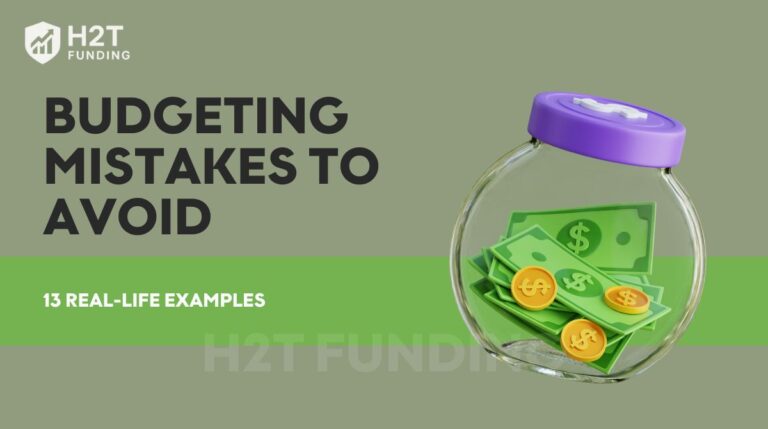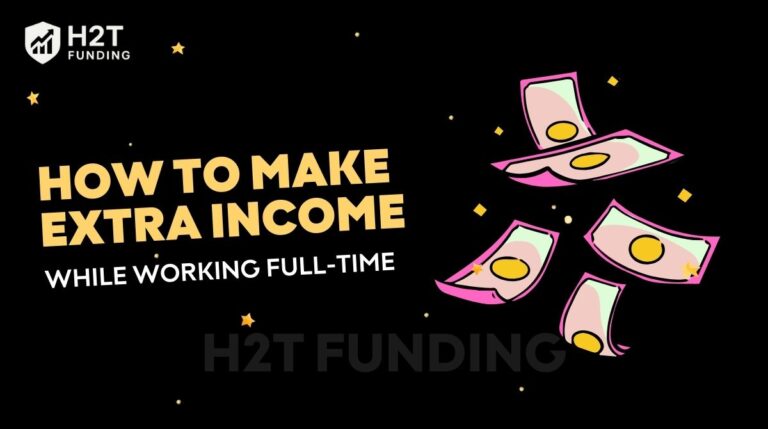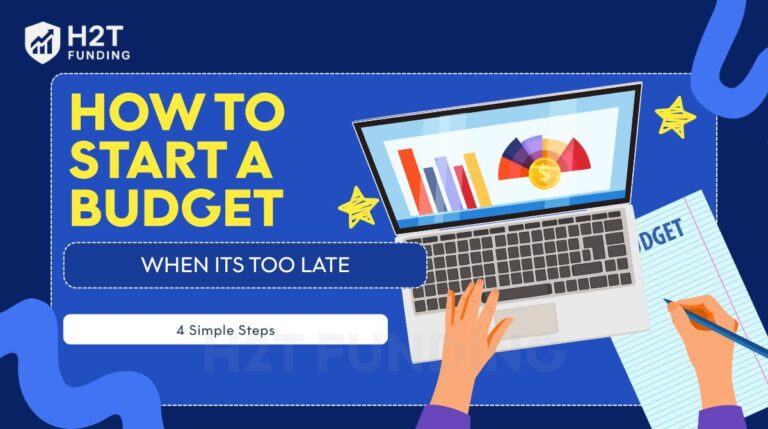Before creating an optimal budget to buy a house by 30, it’s essential to grasp the full scope of what you’re truly saving for. It’s not just the home price; at least 25% of the sale price should be your realistic target before even getting the keys. That total includes the down payment, closing costs, and moving expenses, topped off with a healthy emergency cushion.
Understanding how much money you need to buy a house means breaking these costs into clear categories. With that clarity, you’ll be equipped to build a plan that aligns with your income, lifestyle, and goal of becoming a homeowner by age 30. So what exactly does that critical 25% consist of? Let’s break down each cost together.
1. First, how much money do you really need to buy a house by 30?
Before you can build an optimal budget to buy a house by 30, you need to know exactly what you’re budgeting for. Many people assume they only need to save for the down payment, but the full picture involves several other major costs. From lender fees to moving trucks, every dollar should be accounted for in advance.
1.1. The key costs you need to budget for
Buying a house isn’t just about securing a mortgage; you need a clear picture of all the upfront and ongoing costs. Budgeting properly means accounting for more than just the sticker price of the property. Skipping any of these could leave you financially exposed after move-in.
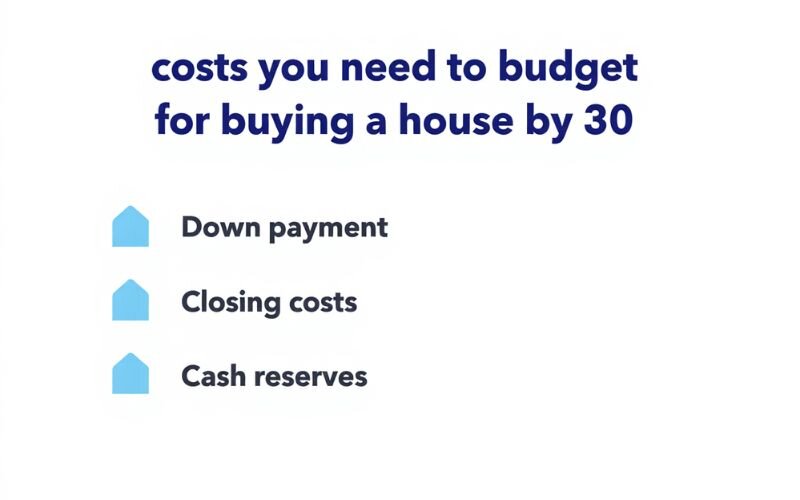
1.1.1. Down payment
The down payment is the largest upfront cost. While many people believe they need to put down 20%, that’s not always required. FHA loans allow for as little as 3.5%, and many conventional loans start at 3–5% down. However, putting down less than 20% usually means you’ll pay PMI (Private Mortgage Insurance)—an added monthly cost that protects the lender, not you.
For example, If you’re buying a $300,000 home:
- A 20% down payment is $60,000
- A 5% down payment is $15,000
But with 5% down, expect to pay PMI until you reach 20% equity.
The important thing to remember is: While putting down 20% isn’t mandatory, a larger down payment is a powerful tool to lower your monthly burden and secure better loan terms. Think of it as an investment in your own peace of mind.
1.1.2. Closing costs
Beyond the down payment, closing costs are another critical set of expenses that can catch buyers off guard. These are the fees and services required to finalize your mortgage and legally transfer the property into your name. They typically range from 2% to 5% of the purchase price, depending on your location and lender.
For a $300,000 home, that’s anywhere from $6,000 to $15,000, on top of your down payment.
Common components of closing costs include:
- Appraisal fee: Confirms the market value of the home for the lender.
- Title search and title insurance: Ensures there are no legal claims on the property.
- Attorney fees: Required in some states to review contracts and oversee the transaction.
- Recording fees: Covers official documentation with local authorities.
- Loan origination fee: Charged by the lender for processing your mortgage application.
A practical piece of advice: Don’t get caught by surprise! Ask your lender for a Loan Estimate as early as possible. These costs are significant, and you must save for them right alongside your down payment.
1.1.3. Cash reserves
Even after you’ve paid the down payment and closing costs, lenders typically want to see that you still have cash reserves, money left over in the bank after the deal is done. These reserves aren’t just a nice-to-have; they’re a sign you can handle your mortgage even if something unexpected happens.
Most lenders prefer that you have enough saved to cover 3 to 6 months of full housing expenses, which include:
- Principal
- Interest
- Property taxes
- Homeowners insurance (collectively known as PITI)
Let’s say your total monthly housing cost is $2,000. You’d ideally want an extra $6,000 to $12,000 in reserve after closing.
Why it matters: Life is unpredictable. A job loss, a medical bill, or even a delayed first paycheck after closing could put you at risk. Cash reserves act as a financial cushion and increase your chances of mortgage approval.
1.2. The hidden costs: Preparing for the long term
Your budgeting journey doesn’t end on the day you close; it’s only the beginning. One of the most common mistakes first-time buyers make is focusing solely on upfront costs and forgetting the long-term financial responsibilities of homeownership. Unlike renting, owning a home means you’re responsible for everything, from a leaky roof to rising property taxes.
To build an optimal budget to buy a house by 30, you need to account for these ongoing expenses from day one. Here are the key categories you should prepare for:
- Property taxes: These vary by location and can increase yearly.
- Homeowners insurance: Protects against damage, theft, and liability.
- Maintenance and repairs: Use the “1% rule”: Budget 1% of your home’s value annually for upkeep.
- Utilities: May be higher than what you paid as a renter, especially for water, electricity, and gas.
- HOA fees (if applicable): Cover community maintenance, security, or amenities in managed developments.
So what’s the lesson here? A wise homeowner isn’t shocked when the water heater breaks. Planning for these costs ahead of time will keep your finances stable and your home a livable space.
Estimated monthly and annual costs for a $300,000 home:
| Expense category | Estimated monthly | Estimated annually |
|---|---|---|
| Property Taxes | $250 | $3,000 |
| Homeowners Insurance | $100 | $1,200 |
| Maintenance (1% rule) | $250 | $3,000 |
| HOA Fees (if applicable) | $75 | $900 |
| Total | $675 | $8,100 |
2. Create your optimal budget to buy a house by 30: A 4-step framework
Now that you have a full picture of how much money you need to buy a house, it’s time to turn that knowledge into action. This 4-step framework is designed to guide you from where you are today to the front door of your first home.
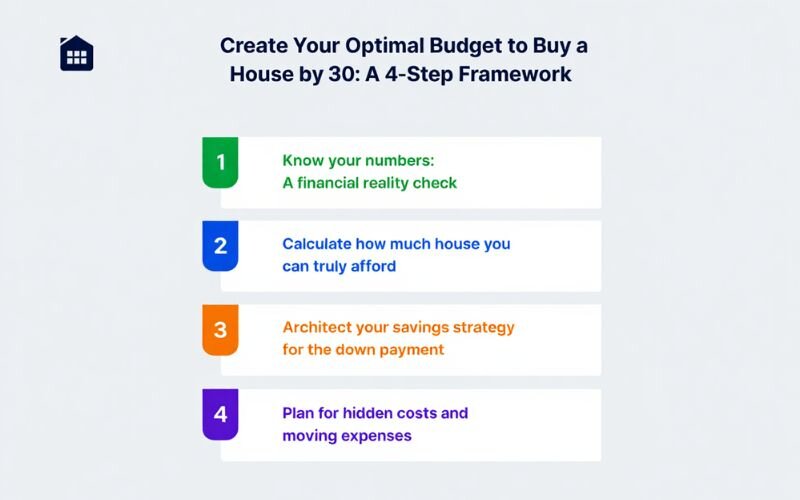
2.1. Step 1: Know your numbers: A financial reality check
Before you start house hunting or even think about mortgage calculators, take a hard look at your current financial position. This step is about knowing exactly where you stand because your credit profile and debt situation will directly determine how much house you can afford, what interest rate you’ll get, and how smooth your loan approval process will be.
Check your credit score
Your credit score plays a crucial role in the mortgage process. A higher score can secure you a lower interest rate, saving you tens of thousands of dollars over the life of your loan. It also makes your application more attractive to lenders.
Here’s how scores are typically categorized:
- Excellent: 740 and above
- Good: 700–739
- Fair: 620–699
- Poor: below 620
Tips: Aim for a score above 740 to unlock the best rates. If you’re below that, now is the time to work on building it up, before you apply for a loan.
Understand your DTI (Debt-to-Income Ratio)
Your DTI (Debt-to-Income Ratio) is another major factor lenders consider. It shows how much of your monthly income goes toward paying off debt, and helps determine how much additional debt (like a mortgage) you can realistically handle.
DTI = (Total monthly debt payments ÷ Gross monthly income) × 100
Example:
- Monthly income: $5,000
- Monthly debt payments (car loan + student loan): $800
- DTI = ($800 ÷ $5,000) × 100 = 16%
The key point here is: Calculate your DTI from the very beginning. It’s like a crystal ball that gives you a strong prediction of how much mortgage you can safely handle.
Maybe you’re interested in: Free debt payoff tracker printable to stay on budget
2.2. Step 2: Calculate how much house you can truly afford
The best way to avoid becoming “house poor”, owning a home but struggling to afford anything else, is by using the 28/36 rule, a trusted guideline in personal finance.
This rule suggests:
- Your monthly housing costs (including principal, interest, taxes, and insurance, PITI) should not exceed 28% of your gross monthly income.
- Your total monthly debt, including your mortgage and other obligations (like student loans or car payments), should stay below 36% of your gross monthly income.
For example, if I make $70,000 a year, how much house can I afford?
Let’s see what the specific numbers look like using the 28/36 rule:
Step 1: Calculate gross monthly income
- $70,000 annual income ÷ 12 = $5,833/month
Step 2: Apply the 28% rule for housing
- $5,833 × 0.28 = $1,633
This is the maximum amount you should spend on monthly housing costs (PITI).
Step 3: Apply the 36% rule for total debt
- $5,833 × 0.36 = $2,100
This is your total allowable monthly debt. If you already pay $400/month toward student loans or a car loan, that leaves $1,700 for housing.
With a monthly housing budget of around $1,600–$1,700, and assuming a 7% interest rate and standard taxes/insurance, you could afford a home priced between $280,000 and $300,000. This will vary depending on your down payment, PMI, and local tax rates, so using an online mortgage calculator is highly recommended to refine your range.
2.3. Step 3: Architect your savings strategy for the down payment
Now that you know your price range, it’s time to design a savings strategy that actually works. Saying “just save more” isn’t helpful. What you need is a system that fits your income, spending habits, and timeline, without feeling overwhelming.
Here are proven strategies to help you build your down payment fund:
- Automate your savings: Set up automatic transfers to a dedicated home savings account right after payday. Treat savings like a fixed bill; it builds consistency without requiring willpower.
- Follow the 50/30/20 rule: Budget 50% of income for needs, 30% for wants, and 20% for savings and debt. Adjust if necessary to boost the savings portion while you’re chasing your goal.
- Increase your income: Consider a part-time job, freelance work, or a monetizable side hustle. Even an extra $300/month adds up to over $3,000 a year toward your goal.
- Cut big expenses, not just lattes: Instead of obsessing over small luxuries, look at your largest monthly costs. Could you move to a cheaper apartment? Share housing with a roommate? Drive a more affordable car? Cutting one big-ticket item can free up hundreds per month.
2.4. Step 4: Plan for hidden costs and moving expenses
These are the hidden costs that don’t show up in your mortgage approval, but they can quickly drain your cash if you’re unprepared.
To avoid financial strain, create a separate category in your homebuying budget for these essential one-time expenses:
- Appraisal and home inspection fees: These are paid up front during the buying process. Expect to spend $300–$500 for an appraisal and $400–$600 for a home inspection, depending on your location.
- Initial repairs and upgrades: Even new homes might need a fresh coat of paint, new locks, or minor fixes. Set aside at least $1,000–$2,000 to cover unexpected updates before moving in.
- Moving expenses: Whether you rent a truck or hire professional movers, relocation isn’t cheap. Budget $500–$1,500 depending on distance, amount of belongings, and labor needs.
- Utilities and setup fees: Starting service for electricity, water, internet, and trash often includes deposits or activation charges. Estimate $200–$400 total.
These “non-mortgage” costs can easily add up to several thousand dollars. Planning for them in advance ensures your transition to homeownership is smooth and stress-free.
3. Expert advice: Common budgeting mistakes young homebuyers make (and how to avoid them)
When I started planning to buy my first home, I thought I had everything figured out: a decent income, a clear savings goal, and even a spreadsheet for tracking expenses. But along the way, I ran into mistakes that cost me time, money, and a lot of stress.
Here are the three biggest budgeting mistakes I personally made, and how I corrected them. If you’re facing any of these, I hope my experience can help you avoid the same missteps.
Mistake 1: I was obsessed with the down payment number
Like many others, I poured all my energy and focus into a single goal: saving enough for the down payment. I thought if I could just hit that magic number, I’d be all set.
But just two months after moving in, the roof started leaking after a heavy rainstorm, and $1,200 vanished from my account, money I hadn’t planned for. I’ll never forget that feeling of panic and helplessness.
How I fixed it: I realized how naive I had been to only look at the surface. I immediately had to tighten my belt for months to build a “home defense” fund. I learned that an emergency fund isn’t a “nice-to-have”; it’s just as crucial as the monthly mortgage payment itself.
Mistake 2: I was almost blinded by the ‘maximum number’.
The bank approved me for a $400,000 loan, and my ego almost pushed me to buy a house at that exact limit. Luckily, a friend gave me a reality check: “Owning the home feels great, until you can’t even afford a weekend coffee.” That sentence was a wake-up call.
How I fixed it: I took a deep breath and decided to target a $320,000 home instead. That decision didn’t just free up cash each month; it freed me from invisible stress, allowing me to truly live in my home, not just work to pay for it.
Mistake 3: I was overconfident, thinking, ‘I’ll just save it back up after closing’.
That was a huge mistake. A few weeks after moving in, the HVAC system suddenly failed. I had to swallow my pride and borrow money from my family to fix it. That feeling of being a new homeowner who already had to borrow money was just awful.
How I fixed it: I realized an emergency fund isn’t the ‘final step’; it has to be a ‘parallel step’. I had to pause all other plans for three months just to grind and rebuild that fund. Those were tough months, but they gave me a sense of financial control that no amount of money can buy.
Budgeting isn’t just about getting approved; it’s about preparing to be a homeowner. If you build in room for the unexpected, you’ll not only buy smart, you’ll own smart.
See more related articles:
4. Frequently asked questions (FAQs)
Use the 28/36 rule as your guide. If you make $70,000 a year, aim for a home where the monthly housing cost is no more than $1,633. This typically means a purchase price of around $280,000–$300,000.
If your loan interest is high (over 6–7%), focus on paying it off first. For low-interest loans, you can save for a home while making minimum payments. A balanced strategy often works best.
If you save $1,000 a month, it’ll take about 3.5 years to reach $40,000. Starting at age 25 or 26 makes it realistic to buy by 30, especially with a steady income and clear savings goals.
5. Conclusion
The homebuying journey isn’t a sprint; it’s a marathon that demands persistence. Creating an optimal budget to buy a house by 30 is the map that keeps you from getting lost along the way.
Remember, every dollar you save today is another brick in the dream home of tomorrow. Don’t just dream about it, start planning today, because your first home is waiting for you at the end of this path.
With the right plan, buying your first home isn’t just a dream; it’s a timeline you control. For more insights and practical guidance, check out other articles in the Budgeting Strategies section at H2T Funding.

